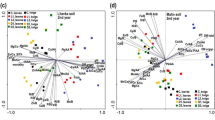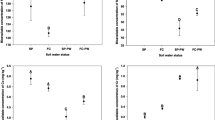Abstract
Willows (Salix spp.) are considered to be effective for the phytoremediation of trace elements from contaminated soils, but their efficiency is limited in heavily polluted soils because of poor growth. Liming can be a desirable measure to decrease the plant availability of elements, resulting in improved plant development. Notably, large root area and maximum soil penetration are basic parameters that improve the efficiency of phytoremediation. The impact of soil chemical properties on willow root anatomy and the distribution of trace elements below-ground have rarely been studied. The effect of liming on root parameters, biomass allocation and trace element distribution in non-harvestable (coarse roots, fine roots, stumps) and harvestable plant parts (twigs and leaves) of Salix × smithiana was assessed at the end of a 4-year pot experiment with two trace element-polluted soils that differed in terms of soil pH. Stump biomass predominated in weakly acidic soil. In neutral soil, the majority of biomass was located in fine roots and stumps; the difference from other plant parts was minor. Trace elements were the most concentrated in fine roots. Translocation to above-ground biomass increased as follows: Pb < As < Zn~Cd. In contrast to Cd and Zn, great differences in As and Pb mobility in plants were recorded after measurements of individual below-ground biomass (stumps < coarse roots < fine roots). Lime application decreased the concentrations of mobile Cd and Zn and related levels in plants, improved biomass production and root parameters and increased the removal of all trace elements in weakly acidic soil. None or minimum differences in the monitored parameters were recorded for dolomite treatments in both soils. The dose and source of liming had crucial effects on root anatomy. Growing willows in limed trace element-polluted soils is a suitable measure for combination of two remediation strategies, i.e. phytoextraction of Cd and Zn and assisted phytostabilization of As and Pb.

Similar content being viewed by others
References
Bouma TJ, Nielsen KL, Koutstaal B (2000) Sample preparation and scanning protocol for computerised analysis of root length and diameter. Plant Soil 218:185–196
Cloutier-Hurteau B, Turmel MC, Mercier C, Courchesne F (2014) The sequestration of trace elements by willow (Salix purpurea)—which soil properties favor uptake and accumulation? Environ Sci Pollut Res 21:4759–4771
Cocozza C, Maiuro L, Tognetti R (2011) Mapping cadmium distribution in roots of Salicaceae through scanning electron microscopy with x-ray microanalysis. iForest 4:113–120
de Andrade RP, Figueiredo BR, de Mello JWV, Santos JCZ, Zandonadi LU (2008) Control of geochemical mobility of arsenic by liming in materials subjected to acid mine drainage. J Soils Sediments 8:123–129
Finnegan PM, Chen W (2012) Arsenic toxicity: the effects on plant metabolism. Front Physiol 3:1–18
Gonzalez-Oreja JA, Rozas MA, Alkorta I, Garbisu C (2008) Dendroremediation of heavy metal polluted soils. Rev Environ Health 23:223–234
Guo YY, Wang JJ, Kong DL, Wang W, Guo DL, Wang YB, Xie QL, Liu YS, Zeng H (2013) Fine root branch orders contribute differentially to uptake, allocation, and return of potentially toxic metals. Environ Sci Technol 47:11465–11472
Hytönen J (2005) Effects of liming on the growth of birch and willow on cut-away peat substrates in greenhouse. Baltic For 11:68–74
ISO 10390 (2011) Soil quality—determination of pH. Czech Standardization Organization, pp 1-12 [in Czech]
Jarvis MD, Leung DWM (2002) Chelated lead transport in Pinus radiata: an ultrastructural study. Environ Exp Bot 48:21–32
Javaux M, Schröder T, Vanderborght J, Vereecken H (2008) Use of a three-dimensional detailed modeling approach for predicting root water uptake. Vadose Zone J 7:1079–1088
Jensen JK, Holm PE, Nejrup J, Larsen MB, Borggaard OK (2009) The potential of willow for remediation of heavy metal polluted calcareous urban soils. Environ Pollut 157:931–937
Kacálková L, Tlustoš P, Száková J (2014) Chromium, nickel, cadmium, and lead accumulation in maize, sunflower, willow, and poplar. Pol J Environ Stud 23:753–761
Keller C, Hammer D, Kayser A, Richner W, Brodbeck M, Sennhauser M (2003) Root development and heavy metal phytoextraction efficiency: comparison of different plant species in the field. Plant Soil 249:67–81
Konopka B, Takáčová E (2010) Effect of liming and NPK-fertilization on the soil and fine roots in a Norway spruce stand, Nízke Tatry MTS. Ekol Bratislava 29:28–39
Kubátová P, Hejcman M, Száková J, Vondráčková S, Tlustoš P (2016) Effect of sewage sludge application on biomass production and concentrations of Cd, Pb and Zn in shoots of Salix and Populus clones: improvement of phytoremediation efficiency in contaminated soils. BioEnergy Res 9:809–819
Kumar S, Dubey RS, Tripathi RD, Chakrabarty D, Trivedi PK (2015) Omics and biotechnology of arsenic stress and detoxification in plants: current updates and prospective. Environ Int 74:221–230
Kuzovkina YA, Knee M, Quigley MF (2015) Cadmium and copper uptake and translocation in five willow (Salix L.) species. Int J Phytoremediat 6:269–287
Langer I, Syafruddin S, Steinkellner S, Puschenreiter M, Wenzel WW (2010) Plant growth and root morphology of Phaseolus vulgaris L. grown in a split-root system is affected by heterogeneity of crude oil pollution and mycorrhizal colonization. Plant Soil 332:339–355
Lee SH, Lee JS, Choi YJ, Kim JG (2009) In situ stabilization of cadmium-, lead-, and zinc-contaminated soil using various amendments. Chemosphere 77:1069–1075
Lux A, Martinka M, Vaculík M, White PJ (2011) Root responses to cadmium in the rhizosphere: a review. J Exp Bot 62:21–37
Mader P, Száková J, Miholová D (1998) Classical dry ashing of biological and agricultural materials. Part II. Losses of analytes due to their retention in an insoluble residue. Analusis 26:121–129
Martin D, Vollenweider P, Buttler A, Günthardt-Goerg MS (2006) Bioindication of heavy metal contamination in vegetable gardens. For Snow Landsc Res 80:169–180
Mathe-Gaspar G, Anton A (2005) Phytoremediation study: factors influencing heavy metal uptake of plants. Acta Biol Szeged 49:69–70
McGonigle T (1994) Estimation of root length and colonization by mycorrhizal fungi. In: Brundrett M et al (eds) Practical methods in mycorrhiza research. Mycologue Publications, Sidney, pp 51–53
Moreno-Jimenez E, Esteban E, Penalosa JM (2012) The fate of arsenic in soil-plant systems. Rev Environ Contam Toxicol 215:1–37
Paradelo R, Virto I, Chenu C (2015) Net effect of liming on soil organic carbon stocks: a review. Agric Ecosyst Environ 202:98–107
Pulford ID, Watson C (2003) Phytoremediation of heavy metal-contaminated land by trees—a review. Environ Int 29:529–540
Quevauviller P (1998) Operationally defined extraction procedures for soil and sediment analysis—I. Standardization. Trac-Trends Anal Chem 17:289–298
Rytter RM, Hansson AC (1996) Seasonal amount, growth and depth distribution of fine roots in an irrigated and fertilized Salix viminalis L. plantation. Biomass Bioenergy 11:129–137
Sharma P, Dubey RS (2005) Lead toxicity in plants. Braz J Plant Physiol 17:35–52
Simon M, González V, de Haro S, García I (2015) Are soil amendments able to restore arsenic-contaminated alkaline soils? J Soils Sediments 15:117–125
Šottníková A, Lunáčková L, Masarovičová E, Lux A, Streško V (2003) Changes in the rooting and growth of willows and poplars induced by cadmium. Biol Plant 46:129–131
Stobrawa K, Lorenc-Plucińska G (2007) Changes in antioxidant enzyme activity in the fine roots of black poplar (Populus nigra L.) and cottonwood (Populus deltoides Bartr. ex Marsch) in a heavy-metal-polluted environment. Plant Soil 298:57–68
Száková J, Tlustoš P, Balík J, Pavlíková D, Balíková M (2000) Efficiency of extractants to release As, Cd and Zn from main soil compartments. Analusis 28:808–812
Száková J, Tlustoš P, Pavlíková D, Hanč A, Batysta M (2007) Effect of addition of ameliorative materials on the distribution of As, Cd, Pb, and Zn in extractable soil fractions. Chem Pap 61:276–281
Tangahu BV, Abdullah SRS, Basri H, Idris M, Anuar N, Mukhlisin M (2011) A review on heavy metals (As, Pb, and Hg) uptake by plants through phytoremediation. Int J Chem Eng 2011:1–31
Tian SK, Lu LL, Yang XE, Huang HG, Brown P, Labavitch J, He ZL (2011) The impact of EDTA on lead distribution and speciation in the accumulator Sedum alfredii by synchrotron X-ray investigation. Environ Pollut 159:782–788
Tlustoš P, van Dijk D, Száková J, Pavlíková D (1994) Cd and Zn release through the selected extractants. Rostl Výr 40:1107–1121
Tlustoš P, Száková J, Kořínek K, Pavlíková D, Hanč A, Balík J (2006) The effect of liming on cadmium, lead, and zinc uptake reduction by spring wheat grown in contaminated soil. Plant Soil Environ 52:16–24
Tlustoš P, Száková J, Vysloužilová M, Pavlíková D, Weger J, Javorská H (2007) Variation in the uptake of arsenic, cadmium, lead, and zinc by different species of willows Salix spp. grown in contaminated soils. Cent Eur J Biol 2:254–276
Trakal L, Neuberg M, Tlustoš P, Száková J, Tejnecký V, Drábek O (2011) Dolomite limestone application as a chemical immobilization of metal-contaminated soil. Plant Soil Environ 57:173–179
Vaculík M, Konlechner C, Langer I, Adlassnig W, Puschenreiter M, Lux A, Hauser MT (2012) Root anatomy and element distribution vary between two Salix caprea isolates with different Cd accumulation capacities. Environ Pollut 163:117–126
Vamerali T, Bandiera M, Coletto L, Zanetti F, Dickinson NM, Mosca G (2009) Phytoremediation trials on metal- and arsenic-contaminated pyrite wastes (Torviscosa, Italy). Environ Pollut 157:887–894
Vandecasteele B, Meers E, Vervaeke P, De Vos B, Quataert P, Tack FMG (2005) Growth and trace metal accumulation of two Salix clones on sediment-derived soils with increasing contamination levels. Chemosphere 58:995–1002
Vaněk A, Ettler V, Grygar T, Borůvka L, Šebek O, Drábek O (2008) Combined chemical and mineralogical evidence for heavy metal binding in mining- and smelting-affected alluvial soils. Pedosphere 18:464–478
Violante A, Cozzolino V, Perelomov L, Caporale AG, Pigna M (2010) Mobility and bioavailability of heavy metals and metalloids in soil environments. J Soil Sci Plant Nutr 10:268–292
Vondráčková S, Hejcman M, Tlustoš P, Száková J (2013) Effect of quick lime and dolomite application on mobility of elements (Cd, Zn, Pb, As, Fe, and Mn) in contaminated soils. Pol J Environ Stud 22:577–589
Vondráčková S, Tlustoš P, Hejcman M, Száková J (2017) Regulation of macro, micro, and toxic element uptake by Salix × smithiana using liming of heavily contaminated soils. J Soils Sediments 17:1279–1290
Vysloužilová M, Tlustoš P, Száková J, Pavlíková D (2003) As, Cd, Pb and Zn uptake by Salix spp. clones grown in soils enriched by high loads of these elements. Plant Soil Environ 49:191–196
Vysloužilová M, Puschenreiter M, Wieshammer G, Wenzel WW (2006) Rhizosphere characteristics, heavy metal accumulation and growth performance of two willow (Salix × rubens) clones. Plant Soil Environ 52:353–361
Wei S, Zhou Q (2006) Phytoremediation of cadmium-contaminated soils by Rorippa globosa using two-phase planting. Environ Sci Pollut Res 13:151–155
Zacchini M, Pietrini F, Mugnozza GS, Iori V, Pietrosanti L, Massacci A (2009) Metal tolerance, accumulation and translocation in poplar and willow clones treated with cadmium in hydroponics. Water Air Soil Pollut 197:23–34
Zhivotovsky OP, Kuzovkina JA, Schulthess CP, Morris T, Pettinelli D, Ge M (2011) Hydroponic screening of willows (Salix L.) for lead tolerance and accumulation. Int J Phytoremediat 13:75–94
Zimmer D, Kruse J, Baum C, Borca C, Laue M, Hause G, Meissner R, Leinweber P (2011) Spatial distribution of arsenic and heavy metals in willow roots from a contaminated floodplain soil measured by X-ray fluorescence spectroscopy. Sci Total Environ 409:4094–4100
Acknowledgements
The finalisation of the paper was supported by the Czech University of Life Sciences in Prague (CIGA 20142005, CIGA 20172016).
Author information
Authors and Affiliations
Corresponding author
Additional information
Responsible editor: Elena Maestri
Rights and permissions
About this article
Cite this article
Vondráčková, S., Tlustoš, P. & Száková, J. Can liming change root anatomy, biomass allocation and trace element distribution among plant parts of Salix × smithiana in trace element-polluted soils?. Environ Sci Pollut Res 24, 19201–19210 (2017). https://doi.org/10.1007/s11356-017-9510-7
Received:
Accepted:
Published:
Issue Date:
DOI: https://doi.org/10.1007/s11356-017-9510-7




